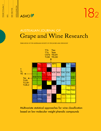Software
Ultra fast prediction of DFT bond and atom properties: Bond energies and atomic charges
SPINUS: Structure-Based Predictions in NMR Spectroscopy
SPINUS is an on-going project for the development of structure-based tools for fast prediction of NMR spectra. SPINUS - WEB
currently accepts molecular structures via a Java molecular editor, and predicts 1H NMR spectra. The predictions are obtained from ensembles of previously trained feed-forward neural networks. Since 2006, the predictions of 1H NMR chemical shifts and coupling constants of the nmrdb.org web service (École Polytechnique Fédérale de Lausanne) are calculated by SPINUS, which, by this way, also provides predictions for the ChemExper web service. SPINUS web services currently receive more than 35,000 hits/month. Access to the system is freely accessible from http://www.dq.fct.unl.pt/spinus or http://neural.dq.fct.unl.pt/jas/spinus . For more information please contact jas@fct.unl.pt.
MOLinsight - A web portal for the processing of molecular structures by blind students
The MOLinsight web portal is a gateway to open-source software as well as software freely accessible to students that can be integrated in strategies for blind users to process chemical structures. It includes the NavMol program.
is a molecular editor for visually impaired users. It enables the interpretation of molecular structures and reactions, and the edition of molecules. It also allows structures to be changed by adding or deleting atoms and bonds. Users can interact with the program via the keyboard and text-to-speech software, or Braille hardware. The user can navigate the molecule atom-by-atom, getting information about atoms, neighbors and connectivity. The current version has been developed in JavaTM. This language was chosen because of its advantages on integration with several different operating systems. Furthermore, Java has native support for accessibility technologies which are made available to screen readers, e.g. JAWS and NVDA, through the Java-access-bridge interface. This technology is not yet fully supported by all screen readers and therefore NavMol also includes a native speech synthesizer (FreeTTS) and support for the eSpeak software. This version of NavMol is based on the CDK and JchemPaint libraries, both written in Java. NavMol is built for visually impaired users but, nevertheless, it still shows a visual representation of the molecular structure (as a 2D sketch). This is so that, when needed, it enhances the interactivity of sighted users with visually impaired ones, as for example, when working in an inclusive class environment. The sighted user can follow the steps made by the visually impaired user, marked on the screen by a blue cursor that moves from atom to atom on the molecule sketch. The first version of the NavMol molecular editor was written by Prof. João Aires de Sousa. NavMol 2 was developed by Dr. Rui Fartaria.
NavMol 3.0 was developed from previous versions mainly by Dr. Yuri Binev. NavMol 3 is capable of loading and navigating reactions from files in the MDL RXN format including atom-to-atom mapping. Reaction edition was implemented making use of atom-to-atom mapping. Optional spatialized audio has also been implemented in a collaboration with Prof. Sofia Cavaco, based on JOAL/OpenAL and HTRF files, to aid in describing the structures.
For more information please see a) F. Pereira, J. Aires-de-Sousa, V. D. B. Bonifacio, P. Mata, A. M. Lobo, "MOLinsight: A Web Portal for the Processing of Molecular Structures by Blind Students", J. Chem. Educ. 2011, 88(3), 361–362; b) R.P.S. Fartaria, F. Pereira, V.D.B. Bonifácio, P. Mata, J. Aires-de-Sousa, A.M. Lobo, "NavMol 2.0 – A Molecular Structure Navigator/Editor for Blind and Visually Impaired Users", Eur. J. Org. Chem. 2013, 8, 1415–1419; c) Binev Y, Peixoto D, Pereira F, Rodrigues I, Cavaco S, Lobo AM, Aires-de-Sousa J. "NavMol 3.0: enabling the representation of metabolic reactions by blind users". Bioinformatics 2018, 34(1), 120-121; or contact Prof. João Aires de Sousa (jas@fct.unl.pt).
JATOON: Java Tools for Neural Networks
JATOON has been developed as Java applets for training and applying neural networks. In version 1.0 three architectures have been implemented: Kohonen self-organizing maps, counter-propagation neural networks, and back-propagation neural networks.
Some features of JATOON are:
The software is freely accessible on-line or to download from http://neural.dq.fct.unl.pt/jas/jatoon. Screen shots of the interface are available. For more details, or for a Java application version please contact jas@fct.unl.pt
- simple and intuitive GUI
- 'live' visualization of maps during training
- monitoring of BPG NN training by continuous evaluation of a test set
- prediction and mapping of new objects after training
A Jatoon screenshot has made the cover page of the Australian Journal of Grape and Wine Research June 2012 issue. It was used in the classification of Portuguese wines.
SEQREP1 is a Java application that implements virtual potentials for the representation of DNA sequences. In the current version the main functionalities of the software are
SEQREP1 can be downloaded as a zip file. Documentation is included in the zip file and is also available online.
- Coding DNA sequences into SEQREP codes starting from FASTA files.
- Training Kohonen self-organizing maps (SOMs) with DNA sequences represented as SEQREP codes, and visualization of the results.
- Application of trained SOMs to new sequences (mapping of the sequences and their automatic classification).

